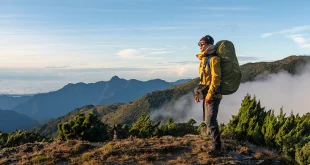Hiking in snow and winter conditions is unlike any other hiking experience. The serene beauty of snow-covered landscapes and the challenge of navigating icy trails make winter hikes incredibly rewarding, but they also require special preparation and care. Having hiked through snowy and cold environments for years, I’ve learned firsthand what it takes to enjoy and stay safe during winter hikes. In this guide, I will share everything I’ve learned about how to hike in snow and winter conditions, from the right gear to tips for handling the harsh elements.
The Challenges of Hiking in Winter
Before I began hiking in snow and winter conditions, I didn’t fully understand the added difficulties that cold weather and snow bring to the table. Winter hikes often come with challenges like icy patches, deeper snow, and shorter daylight hours. These factors make the terrain trickier to navigate, and the weather can shift unpredictably. In addition to the physical demands, the risk of hypothermia and frostbite becomes a real concern if you’re not prepared. Understanding these risks has helped me approach winter hiking with caution, always ensuring that I am properly equipped and ready to face the conditions.
How Winter Hiking Differs From Other Seasons
When I started exploring how to hike in snow and winter conditions, one of the biggest lessons I learned was how different winter hiking is from hiking in the warmer months. Cold temperatures, snow, and ice require extra planning and special gear. For example, snow can quickly turn a dry, stable trail into a slippery, uneven surface that challenges even the most experienced hikers. The same goes for icy trails, which demand extra attention to foot placement and balance. Additionally, winter hikes require more energy, as moving through snow and battling the cold takes a toll on your body, even if you are an experienced hiker.
Essential Gear for Hiking in Snow and Winter Conditions
One of the most important lessons I’ve learned is that the right gear is critical when hiking in snow and winter conditions. Having the wrong clothing, equipment, or accessories can make the difference between a safe, enjoyable hike and an uncomfortable, dangerous experience. After countless winter hikes, here are the essentials that I always bring along.
Layering for Warmth
I cannot stress enough how important it is to layer properly when hiking in winter. Layering helps me adjust my body temperature to the changing conditions. I usually start with a moisture-wicking base layer, which helps pull sweat away from my skin. For the middle layer, I opt for something insulating like fleece or down, which retains heat without making me feel too bulky. Finally, I wear an outer layer that is both waterproof and windproof to protect against snow and chilly winds. The flexibility to add or remove layers as I heat up or cool down is a game changer for staying comfortable.
Footwear: Staying Dry and Stable
In snowy conditions, your footwear is perhaps the most important piece of equipment. I always wear waterproof, insulated boots to keep my feet warm and dry. Snow can quickly seep into boots that aren’t waterproof, which can lead to frostbite or just plain discomfort. Boots with solid traction are essential for maintaining stability on slippery surfaces. Additionally, I pack microspikes or crampons to add traction to my boots in particularly icy conditions. This extra grip gives me confidence to navigate even the most slippery sections of the trail safely.
Gaiters: Essential for Keeping Snow Out
Another item I never forget is gaiters. These handy accessories are worn over your boots and lower legs to keep snow from getting into your boots or pants. When I’m hiking through deep snow, gaiters are essential because they keep me dry and prevent snow from making my legs wet and cold. They also help protect me from brush and debris that might brush against my legs on narrower trails.
Trekking Poles: Support and Stability
When learning how to hike in snow and winter conditions, I quickly realized how useful trekking poles are. Not only do they help distribute my weight and reduce the strain on my joints, but they also offer extra stability. In deep snow or icy areas, poles act as a third and fourth point of contact with the ground, giving me more balance as I walk. They’re also helpful when crossing uneven terrain or when I need extra support while climbing or descending.
Winter Hiking Safety Tips
While it’s exciting to think about hiking in snow and winter conditions, I’ve learned that being prepared is the key to having a safe and enjoyable hike. Winter hiking involves different risks, and the colder weather adds an extra level of difficulty. Below, I’ve listed some essential safety tips I always follow before, during, and after my winter hikes.
Plan Ahead and Check Weather Forecasts
Before heading out on a winter hike, I always check the weather forecast. A sudden snowstorm, freezing rain, or high winds can make a hike dangerous, so I make sure to know exactly what the conditions will be like. I also look up trail conditions, as some paths may be closed or impassable due to snow buildup, avalanches, or other factors. Being informed allows me to make better decisions about where and when to hike.
Start Early and Keep Track of Time
Because winter days are shorter, I always start my hikes early to ensure I have enough daylight. The low sun and the snow can reduce visibility, making it harder to navigate if you’re still on the trail after sunset. I make sure to give myself plenty of time to complete the hike before dark sets in. If I’m hiking a long trail, I also bring a headlamp just in case I need it. Being out in the dark in winter conditions is dangerous, especially if you’re far from the trailhead.
Hydrate and Keep Energy Levels Up
I’ve found that winter hiking can be just as strenuous as hiking in summer, even though it doesn’t always feel that way. The cold air dehydrates me just as much as the heat of summer does. I always bring plenty of water to stay hydrated. On top of that, I bring energy-dense snacks like nuts, granola bars, and jerky to keep my energy levels up. These snacks are lightweight and easy to carry but provide me with the fuel I need to keep going, even in harsh conditions.
Take Frequent Breaks
One mistake I made early on was pushing myself too hard without taking enough breaks. Hiking in snow and winter conditions requires more energy than hiking in warmer months, and I’ve learned to pace myself. I take frequent breaks to rest, warm up, and hydrate. These breaks also give me a chance to check my gear, making sure that I’m still comfortable and that nothing is too cold or wet.
How to Handle Snow and Ice on the Trail
Navigating snowy and icy terrain requires skill and patience. There are a few techniques that I’ve found helpful for staying safe when walking through snow or dealing with ice.
Walking Through Deep Snow
When trekking through deep snow, I always make sure to take small, deliberate steps. In soft snow, my poles help me keep my balance, and I try to avoid sinking too deep into the snow by distributing my weight evenly. If the snow is especially deep, I adjust my pace to avoid tiring myself out too quickly.
Dealing with Icy Trails
Icy patches are one of the trickiest parts of how to hike in snow and winter conditions. When I come across icy trails, I slow down and focus on my foot placement. Sometimes, I’ll attach microspikes or crampons to my boots to give me extra grip. I also use my trekking poles for added stability. Always walk carefully, and avoid sudden movements that could throw you off balance.
Conclusion
Hiking in snow and winter conditions can be one of the most rewarding outdoor activities, offering a serene and quiet experience that you simply can’t get in warmer weather. But as I’ve learned, it also requires careful planning, the right gear, and a strong understanding of how to adapt to the cold and challenging terrain. By following these tips and being prepared, you can enjoy the beauty of winter hiking while staying safe and comfortable. Happy winter hiking!
 Best Hiking Gear Hike More, Worry Less
Best Hiking Gear Hike More, Worry Less

